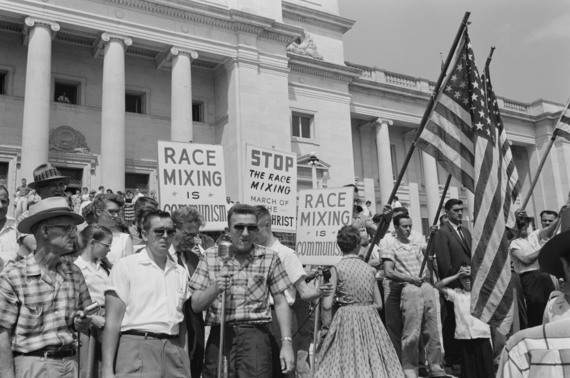
Little Rock, Arkansas 1959. Rally at state capitol, protesting the integration of Central High School. America’s inequality is starkest in its cities, and its schools are a great place to observe it. Delve into any textbook, or ask any high school student when school segregation ended in the United States, and you will probably get some variation of the same response. He or she will most likely point to 1954 and the landmark Supreme Court case, Brown vs. Board of Education of Topeka. They would be wrong: School segregation, like its big brother, institutional racism, never went away — we just like to pretend it did. In fact, desegregation of schools in the South was a…

Little Rock, Arkansas 1959. Rally at state capitol, protesting the integration of Central High School.
America’s inequality is starkest in its cities, and its schools are a great place to observe it.
Delve into any textbook, or ask any high school student when school segregation ended in the United States, and you will probably get some variation of the same response. He or she will most likely point to 1954 and the landmark Supreme Court case, Brown vs. Board of Education of Topeka.
They would be wrong: School segregation, like its big brother, institutional racism, never went away — we just like to pretend it did.
In fact, desegregation of schools in the South was a long and drawn-out process. Segregationist lawmakers and officials around the country sought to stall desegregation, often taking radical measures to maintain the apparatus of American apartheid. In Little Rock, Arkansas, for example, high schools were shut down between 1958-59. In an attempt to disrupt school integration, the shutdown denied almost 4,000 students, white and black, a year of their education. The consequences of what many refer to as “The Lost Year” were profound and impacted the lives of an entire community.
Americans generally think of school segregation as an ugly historical peculiarity, a thing of the past and a particularly Southern problem. We imagine that it was eliminated by the Civil Rights movement and righteous, forward-thinking policy makers. Unfortunately, this is a part of our national mythology. This dangerous fairytale continues to contribute to misguided policies and inaction on the significant, centuries-long crisis of educational inequality. This lens through which so many view segregation is extremely problematic. It renders institutionalized racism a thing of the past and locates the problem of segregation as an artifact of a bygone era.
As study after study prove, our schools remain segregated and unequal across racial and class lines. As Chief Justice Warren and the Supreme Court unanimously decided in 1954, “(s)eparate educational facilities are inherently unequal.” This was true then and it remains true today. It is important to note that this a nationwide problem that is not isolated to the South. In fact, due to focused efforts to desegregate, schools in the South, while still divided along racial lines, are the least segregated for Black students, while the problem is most pronounced in many northern cities.
In New York State, for example, black and Latino students attend profoundly segregated schools. A 2014 study published by the UCLA’s Civil Rights Project found that “New York has the most segregated schools in the country…black and Latino students in the state had the highest concentration in intensely-segregated public schools.” The study found that the problem is particularly acute in the New York City, where policies like school choice, which provide students with alternatives to their local schools, have actually worsened what it termed “racial isolation.” The researchers argue that without clearly-defined integration protocols, the school choice policy leads to further segregation. While the ability to choose your child’s school is an important educational decision, our schools should also function to promote an improving, inclusive society — they should not be in the business of replicating and reinforcing pre-existing injustices.
There is a growing body of evidence that suggests that integration also has positive educational, behavioral and social outcomes. Attendance at racially-isolated, high-poverty schools by black and Latino students has been linked to a decline in student performance. The evidence suggests that black and Latino students who attend integrated school see improved graduation rates and earnings potential without adversely impacting the academic performance of their white peers. Perhaps most importantly, anecdotal data suggests that students of all races that attended integrating schools felt better prepared to participate in a multiracial society.
Most people think that school segregation is a natural byproduct of people going to school where they live. In some ways, that is true, but only half right; what this tells us is that our country remains profoundly segregated and our cities are the bastions of inequality. School segregation flows down from the kind of housing and economic policies that foster continued inequality across racial lines. Desegregating our schools won’t solve inequality, but maintaining school segregation only serves to recreate and further extend our deepening disparities.
If we pretend these are problems of the past, we stand no chance of fixing them. We will continue to perpetuate racial, ethnic, and class stratification. When the consequences of inequality bubble up, we will blame the victims, not the policies that created them.
— This feed and its contents are the property of The Huffington Post, and use is subject to our terms. It may be used for personal consumption, but may not be distributed on a website.
See the original article here:
























